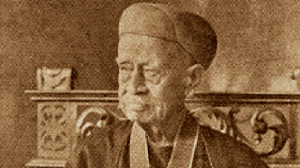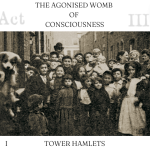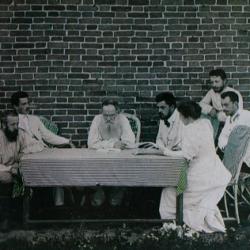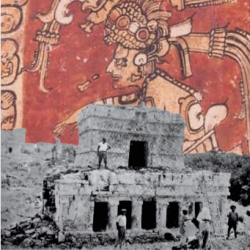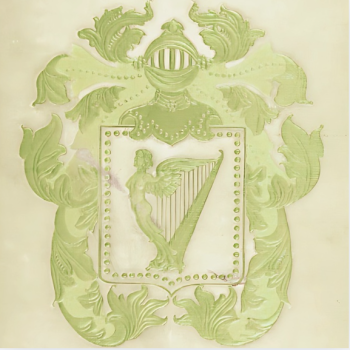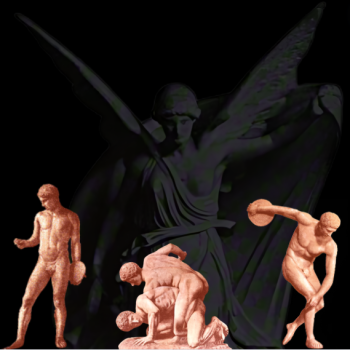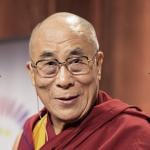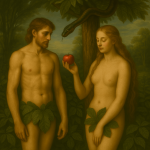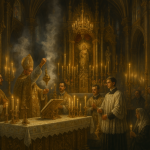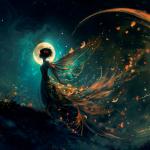OCCULTISM OF SOUTHERN INDIA.
ACT III.
III.
⸻
“Just imagine,” said Verochka, “a certain doctor experimenting with different sorcery until he finally succeeds in summoning the spirit of a horribly wretched dead person. At first he was able to control it, and banish it when he desired, but then it took possession of him more and more, until it finally drove him to commit murder. The actor played the part remarkably well. The transformation was instantaneous, and simply unrecognizable.”[1]
The days leading up to the Convention, were filled with tranquil days of work and pleasant
Conversation.[2] When it was not raining, Charley and Verochka walked along the palm-fringed beach below Madras, where the murmuring surges of the Indian Ocean, broke in tumultuous white thunder upon the sand.[3] They discussed life and loss at leisurely pace as Verochka collected seashells for the children of Rev. Smirnov.[4] This evening they were on the verandah of one of the bungalows at Adyar in the company of Subba Row, Raghunath Row, Srinivasa Row, and Harte. The course of conversation turned to the nature of consciousness, and Verochka described the production of “Jekyll and Hyde” she saw at the Lyceum earlier that summer.
Subba Row then offered his thoughts.
“I think that one may best describe the Indian wisdom in this way: your modern Western science has been chiefly busy with two things, Force and Matter, the Kraft und Stoffof Ludwig Büchner. From experimenting with various materials and elements, your science has gradually risen to the thought of universal Matter; and from handling different forces, mechanical and chemical, heat or electricity, you have gained the general idea of Force. And you perceive that Matter, in a certain sense, is one, continuous, infinite, eternal. Every atom is bound to every atom, to the great All of Matter throughout the universe. And so, of Force. Men of wild imagination used to search for perpetual motion. We know now that the only kind of motion you cannot find, is motion which is not perpetual. All motion goes on forever—rivers, tides, winds, comets, worlds, stars. Every small particle of Force is but a temporary borrowing from the All of Force. Force, like Matter, is one, continuous, eternal, infinite. So, your Western science has these two great generalizations: indestructibility of Matter and Conservation of Energy, the eternity of Force. That is, indeed, the sum of Western science, in the larger view.
“Now we have our basis of comparison for our ancient Eastern science, which had, and still has, its masters. We are most concerned, we have always been most concerned, not with Matter or Force, but with Consciousness; and we say that, of the trinity, Matter, Force, Consciousness, the last is the greatest, since through it, and through it alone, we know the other two.”
“Hypothetical names for our states of consciousness?” asked Harte.
“Exactly. Matter can be known only through the activity of Force, causing phenomena, things knowable, as when an object reflects light to the eyes, and is seen; Force can only be known through its action on Matter, as when the power in the magnet lifts iron; but neither Force nor Matter, thus interdependent, can be known at all except through Consciousness. That is the father; they are the twin children.”
“How would you define Consciousness?” asked Vera.
“A definition of Consciousness? Yes, here is one. Matter, say your textbooks, is that which is capable of manifesting phenomena. Force, I suppose, is that which is capable of causing phenomena. Then Consciousness is that which is capable of perceiving phenomena. The very word ‘phenomena’ is idiotic, unless in relation to Consciousness. It means ‘things appearing’—but appearing to whom? How can things be perceived without a perceiver? So, Consciousness is the primary, these are secondary. Again, your materialists say that Consciousness is a product of Matter because Consciousness is never manifested except through Matter, especially the matter of the brain. Therefore, they say, Consciousness is but a state of Matter, like heat or chemical action, a mere effervescence in the brain-pan. But consider. Force, too, is never manifested except through Matter. Is Force, then, also a product of Matter? Surely no one would say that. Matter is only the necessary condition for the manifestation of the activity of Force to us. Or conversely, as Michael Faraday put it, Matter is never manifested except through Force; the atom may, indeed, be but the place of action Force, and may, as he said, have solid nucleus at all. Neither can manifest without the other. Yes, and we Indians add: Matter and Force cannot manifest except through Consciousness. So, to your dogmas, the eternity of Matter and the Conservation of Energy, we add a third great generalization, the continuity of Consciousness. Consciousness, too, is continuous, infinite, eternal.”
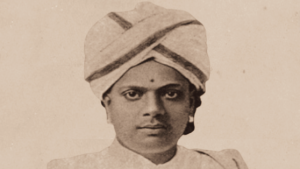
T. Subba Row.
“Subba Row, you are talking like a professor of physics,” interrupted Raghunath Row with a humorous sparkle in his eyes. “Now go on, and speak as a Vedantin.”
“Very well,” Subba Row continued. “Our sages began with Consciousness; began, like the wise men they were, with the one thing they really knew, the one thing any one really knows. They began with Consciousness as they found it in themselves, as it is in each one of us, in you or me: the active consciousness of the waking. personal man. And they cataloged its manifestations: seeing, hearing, taste, touch, smell, feeling, thinking; ranging with them the forces that arouse them: light, sound, and the rest; also ranging beside them the active powers of man: speech, movement, will; the latter always inseparable from Consciousness, as Force is inseparable from Matter in your Western theory. They traced the consciousness of the personal man from morn till night: so much seeing, so much hearing, so much feeling, thinking, willing; from morn till night, from birth till death; with its outlook on men and women, fields and streams, ocean, and sky. Here is the strength of the Eastern wisdom, the door of immortality. They traced consciousness from morn till night, from sensation up to feeling, thought; but they did not stop there, at the boundary. They found, indeed, that there is no boundary—that Consciousness is continuous upward and inward. Your science traces the light of the candle or the heat of the ember back to the sun. Ours traced the light of the mind, the warmth of the heart, back to its sun—Divinity. Not in theory, but in practice, by going thither. Let me try to tell you what they discovered.”
Dewan Bahadur R. Ragunath Row in later years.
Raghunath Row, deeply satisfied with the words of Subba Row, leaned forward in his seat to give him an encouraging pat on the shoulder.
“The Indian sages traced consciousness from morn till night, from waking to sleep, but they did not drop the thread there,” continued Subba Row. “When we sink into sleep, we do not cease to be conscious. We dream, and that, too, is a kind of consciousness. Our dreams are made up of a jumble of images and impressions. Things seen in waking, we see again in dream. Things heard, we hear again, as the Upanishad says. Thus I, at the moment of sinking to sleep after a day in court, hear a turmoil of loud voices. The mind-images of the day are viewed again, confusedly, in dream.

Indian sage, Punjab Hills, India
“Now we come to the great discovery of our sages. Dream is not the end. It is but the ante-room of a deeper consciousness beyond dream. And that deeper consciousness sometimes floods back into dreams, and makes them prophetic, visions of things to come, things already visible from the height of that inner consciousness. This third state we call sushupti, the state beyond waking and dream, which we call jagrat and swapna. And we know the consciousness of sushupti by attending to it. You, too, attend to it, and you will learn it.
“To describe its content? Yes, I can try. But first let me say that swapna and sushupti, dream and what lies beyond dream, are not reached in sleep only. In sleep, they are known apart from waking consciousness, in their distinct, separate character. But they may also be present in waking, as inner, deeper layers of consciousness. For we have daydreams as well as dreams by night. We see the trees and the sky, but at the same time we are watching the images in our minds of the stuff of dreams, our thoughts, and feelings. This may be voluntary, as in the conscious, will-driven act of recalling a fact or a name; or it may be involuntary, as a rush of feelings or memories floods our minds.
“So, of sushupti, the third state, the consciousness that lies beyond dream. That, too, may be present as the background of our waking, though in most men it is quite un-regarded, unheeded, and therefore unknown. But it breathes through the higher layers of dream-consciousness, of thoughts and feelings, both in waking and in sleep. In sleep, it reveals prophetic dreams. In waking, it inspires poetry, truth, religion. It is spiritual consciousness, consciousness of spiritual law, spiritual life. It is mirrored in the mind as the feeling for beauty, truth, righteousness.
“But to return to earth. In the daily waking consciousness of the personal man, things perceived are outward, separate—if you wish, hostile; just as, among savages, all not of one’s tribe are one’s enemies. The realm of waking consciousness is the realm of separateness, contest, antagonism. We learn men by fighting them; nature, by fighting it. In waking, things are either present to our consciousness, or absent from it, as they are in the consciousness of a cat.
“In the next layer, swapna—that which in sleep makes dreams and in waking makes feeling and thought—things are no longer to the same degree outward; they are more inward; they float, as it were, in the inner sea of feeling; the things of feeling are loved or hated, desired, or feared. So, we think of people as lovers or enemies, not as merely present or absent, for our consciousness of people is largely in the second layer. So, through the second layer of Consciousness, we come into emotional and mental touch with other men; we hold their images before our inner eyes, ponder on them, love them, hate them, understand them, or misunderstand them, as it too often is. But in general, we approach them through feeling and thought. And all that realm of life is two-sided; we love, or we hate, we desire, or we fear, we are ambitious, or we despise.
“Then the third realm of Consciousness descends brooding upon that; its words are: unity, life, immortality. When it descends upon the mind, that begins to see oneness, law, the great sweep of forces, universal generalizations; true science and philosophy arise. When it descends upon feeling, bringing with it the word of beauty, it kindles feeling into poetry, aspiration, religion. When it descends upon the images we have made of men in our thoughts, it breathes love, unity, speaks of the oneness of the soul. When it touches the will, it tells of righteousness and immortality.
“When we have gone thus far in the consciousness which we have during daylight, it is a sign that we are growing ready to know the same consciousness in its purity, at the other side of sleep. I have read that Charles Lamb used to say, ‘Young man, tell me your dreams, and I will tell you if you are a poet.’ That is the clue. You enter into sleep. Through the consciousness of dream, you rise to the consciousness beyond dream. That consciousness is joyful.
“It is dominated by three intuitions: the realization of one’s own spiritual being, one’s immortality; the intuition of other souls; the intuition of the One Soul, in which all souls rest, as men walk in the sunshine. It is a deep, strong consciousness, full of love, joy, peace; a consciousness of spiritual forces rather than of images, as consciousness of the immortal; in a word, in the third state, the soul realizes its own spiritual being, it realizes its brothers, the souls of others, it realizes the Father, the One-Self of all beings. You can understand this third consciousness by entering it. You. can enter it by attending to it. Attention is the key of spiritual life, as it is the key of scientific discovery. And spiritual life is the greatest of all discoveries.
“In this third state, the soul feels itself, its kin, its source. That is the great discovery of the East. You can verify it. You can pass through the door. But you must give your whole heart to this, as you do to your discoveries, your explorations, your adventures. This is the great adventure, worth all the others. It needs courage, keenness, love, will, as do all adventures. Try it.
“In this third consciousness, the soul stands on its feet, knows its own life as spiritual and immortal, thrills with the sense of spiritual power, rejoices in its spiritual kin, the souls of others, the immortals. We say that all souls enter into this spiritual consciousness night by night and come forth from it in the morning. That is what gives us life and strength each morning to take up the burden of the new day. If we fail of our draught of Amrita, of nectar, we go mad and die. That is the fountain of life, the living water springing up in the heart, of which your Master speaks. The soul knows itself as immortal, joyful, divine.

Vishnu as Mohini carrying the Amrita.
“Even in the West, where this third consciousness is as yet little recognized or heeded, it is nevertheless abundantly present, coloring the upper layer of feeling and thought, as the sunshine colors the upper layer of the clouds, or as the moon there is gilding the upper layer of the waves. But, falling into the second layer of Consciousness, the layer of emotions and thoughts. this ray shares the nature of these; it takes the form of hopes and fears concerning spiritual life and immortality; for you cannot even doubt that of which you have no consciousness, so doubt itself is but the deflected light of the soul.
“Therefore, that spiritual light is falling on the upper layer of your feelings and thoughts, begetting poetry, aspiration, genuine humanity, which is the recognition of others as souls, as our immortal kin, to be loved with the soul. Falling on the upper layer of your minds, that light from above finds itself in contest against the things which come from beneath: the world-view built up of images of outer things. Spirituality wars with materialism, and the battlefield is the mind. When the earth-images conquer, you call it scientific materialism. When the spiritual rays conquer, you call it religion. It is, in reality, all and question of states of consciousness.
Subba Row grew quiet. The party became suddenly aware of the chirping of innumerable cicadas.
“Listen to the whirr of the crickets, the voices of the world, that fill our ears,” Srinavas said. “But listen, too, to the sound of the ocean, the voice of eternity. We can hear it by listening to it.”
Subba Row began to speak again “That is the content of sushupti, the third consciousness; it is spiritual being, where the soul stands forth in the sunlight, with joy realizing his immortality; with love recognizing his spiritual kin; with awe bowing down before his Father, the One Divine Life.
“Think not that this sublime condition is the end. A glorious consummation surely, but the beginning only of true spiritual life. It is not Nirvana. Far from it. It is rather the first step on the ladder that leads to Nirvana.
“For our masters recognized beyond these three jagrat—swapna, sushupti, which we may call physical, psychical, and spiritual—a fourth, the truly divine consciousness. In that, the man shares the consciousness of God Himself, viewing life from the standpoint of God. He no longer looks upward to God; he looks outward from the heart of God and is one with other souls there. The three are now one: God, my neighbor, myself: all made perfect in the Divine, the Eternal. This is the end, if the Infinite is an end; this is the Brahma-Nirvana of the Bhagavad Gita, the complete conscious oneness with the Divine Being, which Krishna holds before Arjuna as his goal. That is our ideal of immortality—no mere continuation of a personal existence after the death of the body, but the consummation of all being, where man finds his true immortal individuality in God.
“Now we come to a cardinal part of our teaching, the consideration of the soul’s state after death. We hold that the clue through this labyrinth is the study of the deeper states of consciousness during life. Consider the man who sinks to sleep. From waking, he passes first to dreaming, a disturbed consciousness, in part made up of impressions of waking life, in part drawn from above. From dream, he passes into the third consciousness—for the sage and high spiritual state of fully conscious soul-life; but for the most, state from which they return with the sense of refreshment, but with no clear memory. Then, through the margin of morning dreams, the man returns to waking consciousness.
“So is it with death and birth. There is, first, the realm of dreams, painted by the imagination during life, so that they who return from temporary death describe conventional heavens and hells, or, as the mediums, describe their ‘Summerland.’ But this is only the ante-room. The soul then passes on to a state, answering to the third consciousness, of spiritual refreshment and communion, where the inner nature grows, as the outer nature grows in this life; this is the true heaven, the soul’s resting-place. Not a final rest, however, not permanent. When the impulse of aspiration which carried it thither is exhausted, the soul ‘is reborn through the impulses latent in mind,’ as the Upanishad says; it returns through the realm of dreams. And, just as, on waking in the morning, the man has no memory of the spiritual life he has rested in, even though he brings with him its refreshment, so the soul, coming to rebirth, brings with it no clear memory of heaven, yet carries with it the sweet freshness of childhood, the eager willingness to begin life again. But just as, on waking in the morning; the clear-eyed sage remembers the life of the soul which he has known in the realm beyond dream, so, on waking in a new birth, he remembers the heaven he has left, and the long past that his soul has experienced. Both Krishna and Buddha spoke their memories, and others also members—‘Before Abraham was, I am,’ as your Master said.
“Thus, with continuity of Consciousness as our clue, we pass by sure steps from personal Consciousness to Divine Consciousness, one, continuous, infinite. It is all a question of seeking. ‘Seek and ye shall find.’ Go inward, far enough and long enough, with the steady enthusiasm with which you go outward. You are chasing the reflection of the soul; go in the opposite direction and seek the soul itself. Consciousness is a wedge, of which you know only the thin edge. Begin with that; follow it up, see how it opens, onward and upward, into the being of God.
“Now there is another law, of great moment. We have spoken of Consciousness alone, and of states of Consciousness. That was for convenience and clearness. To be accurate, we should have spoken of states of Consciousness and Will, for they go together, like your Matter and Force. Take a few illustrations. When in Babur (the founder of the Mughal Empire in India,) the consciousness of ambition invaded the will, he came down on the plains of India and founded a new empire. When Shah Jahān grieved for his dead wife, Mumtaz Mahal, the Taj Mahal rose into being. When Buddha’s love for all mankind worked through his will, he opened the wide pathway to Nirvana. Will builds the house for Consciousness. Consciousness first makes the plan, and then inhabits the house.
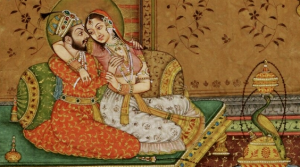
Shah Jahan & Mumtaz Mahal.
“It is so with our evolution. All that Darwin has described is the making of better and higher vestures for individual consciousness. The Will is operative along with Consciousness from the beginning. That is the driving power which raises the amoeba and carries it along the road to manhood. It is this which makes protoplasm live, and no chemical change. Chemical change runs downhill, from unstable to stable compounds; life climbs uphill, and continually produces finer forms.
“Will builds the vesture for Consciousness. So, you have the physical body built for waking Consciousness. And when Consciousness and Will are withdrawn, the building falls. Withdrawn whither? Into nothingness? No, but into a finer vesture built by the will, of etheric elements, just as the physical body is built of chemical elements. Your scientists already divine these etheric elements, going after them from without. We discovered them long ages ago, going after them from within. So, we are familiar with the psychic body, which Saint Paul speaks of, the vesture of the second consciousness. And we also know the spiritual body, the fine, immortal vesture of the third consciousness. There is the fourth, the radiant robe of Nirvana, the ‘glorious body,’ the garment of righteousness. Each is built up, in due season, by the creative power of the Will, always inseparably united with Consciousness.
“This, then, you may say, is the proper field of our Eastern science: Consciousness and Will, directly experienced, and the deeper, higher layers of Consciousness, continued upward from waking life through the psychic and spiritual worlds toward the Divine.”
Subba Row looked at the moon, now sinking into the feathered bed of the palm trees. The waves were thundering in surges on the nearby ghostly shore. “We have our rewards,” he continued, “not in mechanical furniture of life, but life itself; not the fattened mortal, ready for the slaughter, but the immortal man, rising toward full divinity, entering more and more into the being of God, into the consciousness and will of God, growing in power, in bliss, in everlastingness.”[5]
← →
THE AGONIZED WOMB OF CONSCIOUSNESS SECTIONS: “ACT III”
I. TOWER HAMLETS.
III. OCCULTISM OF SOUTHERN INDIA.
IV. THE ONE WHO THINKS HE KNOWS.
SOURCES:
[1] Johnston, V. V. “Letters of Vera Johnston,” July 29, 1888, London, England, entry.
[2] Olcott, Henry Steel. Old Diary Leaves: Volume III. Theosophical Publishing Society. London, England. (1904): 345.
[3] Johnston, V. V. “Letters of Vera Johnston,” November 25, 1888, Adyar, India, entry.
[4] An excerpt from the essay is published in: Zhelikhovskaya, V. P. “London Life” Moskovskie Vedomosti. No. 259 (September 19, 1890.)
[5] Johnston, Charles. “East And West: Helping to Govern India.” The Atlantic Monthly. Vol. 109, No. 3. (March 1912): 324-331.


